THE MURDERER
Anyone who
watched the news in the late 80s early 90s, knew all about this. Our at
least they thought they did.
But here's the REST of the
story...
After my second
divorce, I saw the most attractive girl in Shoney's. More importantly,
she had a personality that would light up a room. Everyone was in love
with her, and I was getting very attracted myself. After meeting
her there many times and striking up conversations, we started dating.
The fact that she lived in southern WV, so far down that they had to
pipe-in sunshine meant that after she got off work at 1am, she had a
long drive in a desolate county at night. I offered to let her
stay
with me several times, and those several times turned out to be every
day and night. I couldn't have been happier with her.
|
 I wont show her face due to the subject matter.
I wont show her face due to the subject matter.
So things were
going along well, until one day there was a knock on the door. Turns
out it was a WV State Trooper. He had some paperwork in his hands
and wanted to talk to my girlfriend. How he found her living with
me I don't know, but I knew this couldn't be good. I went into
another room to let them talk, and the Trooper left. "What was that all
about?" I said. She proceeded to tell me a story that I couldn't
believe....
|
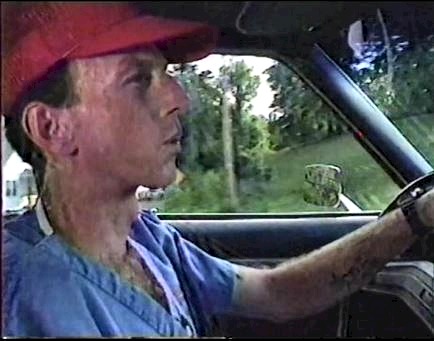
Meet Harold Douglas Gunnoe.
My girlfriend,
we'll call her "Mia" told me the story of a murder that she was somehow
involved in. Before Mia met me, she had met another guy named
Harold Gunnoe at Shoney's. He was a regular customer and like me,
he wanted to know Mia better. He asked her out again and again, but she
refused. She told me that she simply didn't like his looks or
manners. But Gunnoe went behind her to her co-workers and
convinced them to ask Mia to go out with him. Before I go further, let
me say this: The judge at his trial stated that "Gunnoe could talk the birds out of the
trees". This he could. He was a real flim-flam man.
So Gunnoe kept after Mia and even her co-workers told her that she
should go out with him.
Finally, weeks later and after a late night shift at Shoney's, Mia was
about to leave when in walks Gunnoe. Once again he said "Come-on... let's just go out for a quick
drink". Mia was very tired and had a long trip ahead of
her to get back home so she finally relented and went with
Gunnoe. They drove to the "Wagon Wheel" in Cross Lanes and was
there until probably 3 in the morning. At that point it's a
little fuzzy as to what exactly happened next, but they wound-up at the
Sunset motel on Sissonville road.
|

Mia was very
young, a teenager, very gullible, and very stupid at that time.
Gunnoe promised that there would be no hanky-panky and all everyone
wanted to do was get some sleep. Turns out that Gunnoe didn't
sleep all night. He mostly stood around with his clothes on looking out
the window. Around 6am Mia woke up and told Gunnoe to take her
back to her car at Shoney's. This he did, but on the way there he
asked where exactly did she live. Once again, being gullible, she
told him.....
|

Mia
was living with her mother, father, and little sister in southern
WV. It was summer, so school was out and Mia's mother and sister
were home along with Mia herself. Dad was at work. They got a
knock on the door and it's Gunnoe.
He had told Mia previously that he was a heavy equipment salesman, and
on this morning he was traveling to Kentucky to wrap-up a sale, and
since Mia's house was on the way, he'd just stop to say hello.
Only one problem: It was about 11am and by 1pm he was still
there. He then told Mia that he could finish the sale later and
convinced her to go to the movies in Huntington. They got about
halfway when Mia changed her mind and said she wanted to go back home.
They turned around and did just that. The day wore on that Gunnoe is
still there with 3 females alone. The mother told Mia that he HAD
TO GO. Finally around 5:30 Mia's father came home from work in
Charleston. He was a short guy but built like Charles
Atlas. He lifted weights daily. At this point Gunnoe left, and
due to this unwelcome stay he was never attached to Mia again. Oh
sure, he saw her in Shoney's and tried to get her to go out with him
again, but she refused. Lucky her....
|
So now we are
back where we started. Months had passed and now Mia was staying with
me when the Trooper showed up.
|
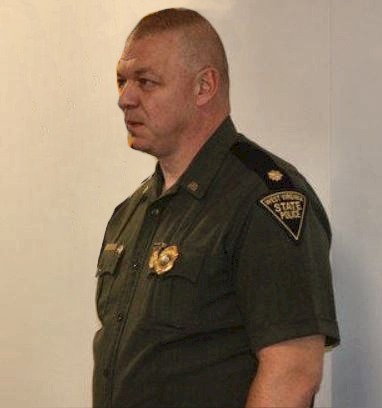
It turns out
that Harold Douglass Gunnoe had been arrested, and during that arrest
he confessed to killing a woman named Veronica Blanton, a counselor who
Gunnoe met in a substance abuse program. She lived in Winfield WV
and that's where Gunnoe murdered her with a knife, and (as I heard it)
took her car for the next week or so and was stopped near Cross Lanes
WV for some infraction, but he also had a warrant for worthless checks.
This is where the
legal system broke down and caused the murder of ANOTHER woman not too
long after.
|
REFRESHER
Backing up
again, here's what happened when the Trooper came to my house: He
told Mia that he had a subpoena for her to appear in the murder
trial of the man she spent the night and following day with, Harold
Douglas Gunnoe. (this was when I learned that my girlfriend was
involved in a murder. Most men would have cut and run right
then).
How was Mia involved? Remember when they had their first date and
spent the night in the motel with Gunnoe never going to bed and looking
out the window for the next 3 hours? That was the SAME night that he
murdered Veronica Blanton and left her lifeless
body in her house. Gunnoe didn't want sex. He was too nervous.
What he wanted was an alibi.
He needed for people to see him both in public and privately to prove
where he was all night, and he chose Mia as his main alibi.
And think about this: He spent most of the following day
with three females all alone deep in the countryside with no
nearby houses! He could have murdered all 3 and no one
would have found their lifeless bodies until after 5pm. So
why didn't he? He'd already murdered one woman. Maybe that
was enough for awhile. Plus, his alibi was more important right
now. Those women had NO idea how close they came to being
murdered! But they wouldn't have been the last...
|
THE TRIAL
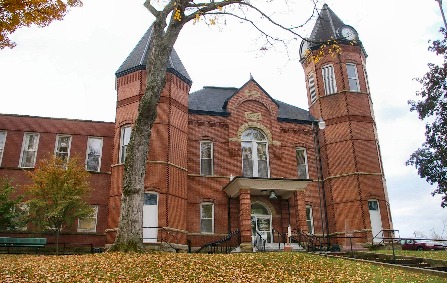 The Putnam County Courthouse.
The Putnam County Courthouse.
Both Mia and
myself sat on the front row of the courtroom, starring at Gunnoe as he
took the stand. He stared back. The trial wasn't that long and Gunnoe,
with all the evidence stacked against him, including Mia's testimony
was found guilty of murder. He
got life without mercy. Well, I'm glad that's
over...... or was it?
|
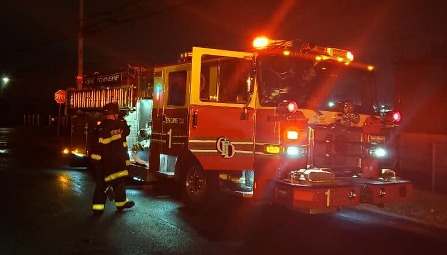
A few years
later while working as a lieutenant on the local fire dept, we got
called to a trash fire behind some apartment houses. It was night, and
I was in charge of the Engine. As I'm watching my gauges, some
crazy man come running out of the darkness yelling about the guy who
had set the trash cans on fire and was trying to burn down his
house. The only light in my area was a street light overhead, and
as the man came closer, I just about flipped out! It was Harold
Douglas Gunnoe! Had to be! So I asked him... what is
your name? "Harold Gunnoe"
he said. "GET THE HELL AWAY
FROM ME!" I
screamed. He had no idea why I was talking to him that way,
because I was in full battle dress with my helmet etc
he just didn't recognize that fact that it was my girlfriend who helped
but him away.
But now he was back. What the hell happened? Why is he out
here living a block from where Mia works? I should also mention
that Mia is now my wife. Yes, I married the girl who was a star
witness in a murder trial. Go figure.
|

That same night
when I got back to the fire house, I called the work release
place which just happened to be a block away. This was a program that
was the first in the U. S. where criminals transited from prison to the
world of tax paying citizens. The idea was to allow them to get
jobs and ease they way back into society, but for awhile, they had to
return to the Work Release building every day. After that, they
could then rent a place to live while still reporting to the work
release building.
I called them up: "Do you have
Harold Douglas Gunnoe on work release?" Yes they said. "How in the hell is that even
possible! He got life without mercy!" Turns out there was some sort of screw up
as he was being arrested and he managed to get his conviction
overturned. So here he is... again. Living close to
where my wife works and free as a bird.
|

This photo was
taken from a video of Gunnoe when he was on work release and working
for Husson's Pizza, delivering food. John Walsh of the famous
"America's Most Wanted" featured Gunnoe on his program concerning
murderers that have gone free and is now out in the public. That video
is on YouTube, and
you can see the video here:
|
SO WHAT HAPPENED NEXT?
Gunnoe, the man
who had already murdered one woman murdered again. This time it was a
well known woman named Alicia McCormick who
worked at the YWCA, and was somewhat sympathetic to people like
Gunnoe. I wont waste my time going through that incident, but
have posted it below if you care to read. This is a classic
example of those who say " The death penalty is cruel and unusual
punishment, and doesn't solve anything". Actually it does,
because Gunnoe isn't the only person who's been let out of prison for
murder and went on to murder again. If I were the family, I would
have taken the second murder case to the highest court in the land
because it was "the system, the state" that murdered Alicia McCormick,
not just Harold Gunnoe...
|
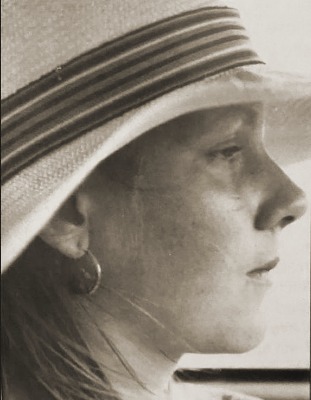
Alicia McCormick
Alicia began at the YWCA Charleston
Resolve Family Abuse Program (RFAP) in April of 1986 as a Counselor and
quickly became the Program Director in May of 1988. In July of
1991 at thirty-two years old and just three brief years after becoming
Program Director, Alicia McCormick was found murdered in her Charleston
apartment by Harold Gunnoe.
|
The
background of Harold Douglas Gunnoe
In
1991, Gunnoe was serving a five-to-18 year imprisonment sentence for
second-degree murder. Gunnoe had stabbed to death Veronica Blanton, a
counselor whom Gunnoe met in a substance abuse program. Gunnoe pled
guilty to second-degree murder after his first-degree murder conviction
for Ms. Blanton's death was overturned on the grounds that an illegally
obtained confession was used as evidence at his trial.
In addition to the murder of Ms. Blanton, Gunnoe had a substantial
record of involvement with the criminal justice system. In over
15-plus years, in addition to the Blanton murder, Gunnoe had been
arrested and charged with forgery, worthless checks, uttering,
burglary, breaking and entering, assault with a deadly weapon, grand
larceny, resisting arrest, escape and parole violation. In a number
of instances, however, no convictions followed the arrests or charges.
On March 28, 1990, after serving about three and one-half years in
prison for Ms. Blanton's murder, Gunnoe was transferred by the DOC from
the medium security prison at Huttonsville, West Virginia, to the
unsecured Charleston Work Release Center.
Gunnoe's conduct at the CWRC was poor. He was removed from his first
“inside” job at the CWRC, a maintenance position, for inadequate work.
He quit or was fired from his first “outside” job. He broke CWRC
rules by cashing his first paycheck instead of turning it in. He was
fired from a second outside job.
In September, 1990 Gunnoe pled guilty to 16 CWRC disciplinary charges
of fraudulent misrepresentation and failure to proceed or return,
before a DOC magistrate. Gunnoe was sentenced to return to
Huttonsville, but the sentence was suspended and Gunnoe was given a
punishment of “lost privileges” for 30 days.
Gunnoe continued to perform poorly. He failed to attend counseling,
failed to turn in his paycheck, and he unlawfully operated a motor
vehicle without insurance. He was fired from a third outside job, and
lied about another job. In May, 1991 he was fired from a fourth
outside job-for poor work habits, bad attitude, and refusal to work.
In June 1991, Gunnoe was discharged from a fifth outside job, because
he “constantly mouthed off, refused work details, refused to work, made
inappropriate comments to females, and had a bad attitude with the
supervisor.” On June 5, 1991, DOC staff summarized Gunnoe's history
at the CWRC in a memo urging his return to Huttonsville, as a “program
failure.”
Meanwhile, in March of 1991, Gunnoe and his then-wife had moved into an
apartment in Charleston, next door to an apartment building owned by
the appellee Smith. (Apparently the CWRC allowed some inmates who were
assigned to the CWRC to reside away from the CWRC, on “furlough”
status.) Smith and Gunnoe spoke, and this conversation led to Gunnoe
beginning to perform part-time maintenance work for Smith on several
rental properties owned by Smith.
Gunnoe and his wife thereafter moved into one of Smith's apartment
buildings, agreeing that any work they performed for Smith would go
toward their rent. Gunnoe's wife cleaned some of Smith's vacant
apartments, and Gunnoe and his father constructed a retaining wall for
Smith.
At some point after Smith met and employed Gunnoe, Smith learned that
Gunnoe was an inmate at the CWRC, that Gunnoe had been in prison, and
that Gunnoe had been convicted of murder.3 According to Smith, Gunnoe
told Smith that Gunnoe had killed a man who raped Gunnoe's sister.4
Alicia McCormick was employed as a domestic violence counselor and
program director for the YWCA in Charleston. She ran an anger control
group that was frequented by work release inmates. On about June 7,
1991, Ms. McCormick moved into an apartment at Smith's Green Meadow
apartments. (Green Meadow was not the building where Gunnoe lived.)
In the latter part of June, 1991, Gunnoe informed DOC employee Becky
Jordan at the CWRC that Gunnoe had met Ms. McCormick “by doing work at
her apartment.” In Ms. Jordan's presence, Gunnoe referred to Ms.
McCormick as a “looker.”
On about July 2, 1991, Ms. McCormick came to the CWRC to discuss with
inmates the relationship between alcohol and violence. Gunnoe was
“hanging out” in the yard, according to Ms. Jordan, and Ms. Jordan and
Ms. McCormick stopped to speak with Gunnoe.
According to Ms. Jordan, Ms. McCormick thanked Gunnoe for hanging
blinds for Ms. McCormick at her apartment, and asked Gunnoe if he could
locate an air conditioner for Ms. McCormick's use. Ms. Jordan
described Gunnoe as “flirting” with Ms. McCormick, because he thought
“she was good looking.” Ms. Jordan believed that Gunnoe was
deliberately present at the CWRC on that occasion because he knew that
Ms. McCormick would be there.
On about July 18, 1991, Gunnoe and Smith were at the apartment building
where Ms. McCormick lived, and Gunnoe whistled at Ms. McCormick as she
came down the stairs. Smith admonished Gunnoe.
On or about July 20, 1991, Gunnoe murdered Ms. McCormick in her
apartment, by stabbing her to death with a knife. Smith had changed
the McCormick apartment locks when Ms. McCormick moved in, and she had
the only key. The Charleston police concluded that Gunnoe's entry to
the McCormick apartment was not forcible.
|
WHY WAS HE LET GO FOR THE FIRST
MURDER?
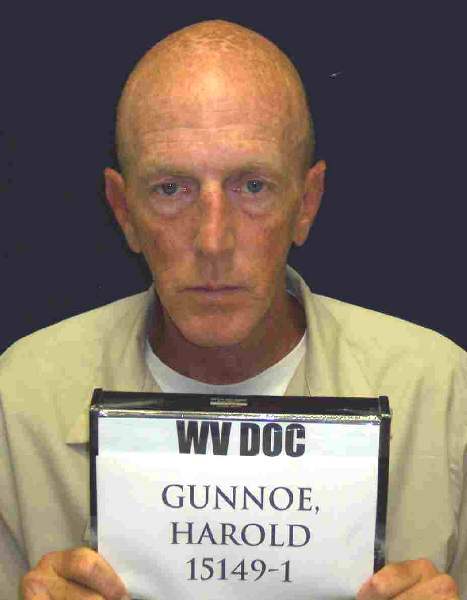
Gunnoe after over 40 years in prison.
Harold Gunnoe, was arrested on September 14, 1986, for uttering
worthless checks. While in custody, he was questioned for several days
regarding the murder of Veronica Blanton, which he denied knowing
anything about. On September 19, 1986, law enforcement officers
requested that he take a polygraph test. Gunnoe expressed a desire to
consult with his attorney before making that decision. The officers
contacted his appointed lawyer for the check case, who indicated that
he had no objection to Gunnoe being questioned about the murder,
provided it did not pertain to the check charges. Gunnoe was informed
of this response, signed a waiver of his Miranda rights, and
subsequently confessed to the murder. He later sought to suppress his
confession, arguing it was involuntary and violated his Fifth Amendment
rights. The trial court denied his motion, leading to his conviction
for first-degree murder without mercy and a life sentence. Gunnoe
appealed, claiming error in the trial court's handling of his
confession. The procedural history included a pretrial hearing where
the court found the confession admissible.
So due to the fact that even after HE CONFESSED to the murder, and the
fact that THEY HAD ALL THE EVIDENCE they needed to convict him,
he was turned loose by a few simple words of the law and another woman
was murdered.
In America, all it takes is a few simple words to allow murderers to go
free to kill again.
|
More to come.... soon.
Back
Index Page
|




